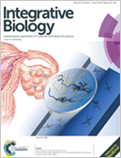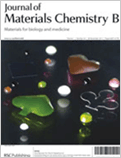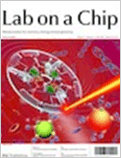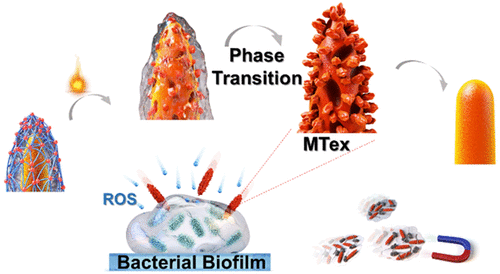













[114] Lab Chip, 21, 3263 - 3288 (2021)
The role of liquid biopsies in prostate cancer management
Chi-Ju Kim+, Liang Dong+, Sarah Amend*, Yoon-Kyoung Cho* and Kenneth Pienta*
The need to appropriately diagnose and guide the serial treatment of men with prostate cancer has led to the implementation of many studies to apply liquid biopsies to prostate cancer management. This review describes recent advancements in isolation and detection technology and the strength and weaknesses of the three circulating biomarkers. The clinical studies based on liquid biopsy results are summarized to depict the future perspective in the role of liquid biopsy on prostate cancer management.
[113] ACS Appl. Nano Mater. 4, 8, 8491–8499(2021)
Superhydrophobic and Self-Sterilizing Surgical Masks Spray-Coated with Carbon Nanotubes
Ritesh Soni, Shalik Ram Joshi, Mamata Karmacharya, Hyegi Min, Shin-Kwan Kim, Sumit Kumar*, Gun-Ho Kim*, Yoon-Kyoung Cho*, and Chang Young Lee*
Here, we report a single-step spray-coating technique for the formation of a superhydrophobic layer of single-walled carbon nanotubes (SWCNTs) on a melt-blown polypropylene (PP) surgical mask. Owing to the cumulative effect of the superhydrophobicity and photothermal performance of the SWCNTs, the CNT-coated masks show 99.99% higher bactericidal performance toward Escherichia coli than pristine masks. Further, the virucidal ability of the SWCNT-coated mask, tested by using virus-like particles, was found to be almost 99% under solar illumination. As the spray-coating method is easily scalable, the nanotube-coated mask provides cost-effective personal protection against respiratory diseases.
[112] J. Am. Chem. Soc. 143, 28, 10582–10589 (2021)
Atomically Conformal Metal Laminations on Plasmonic Nanocrystals for Efficient Catalysis
Anubhab Acharya, Sateesh Dubbu, Sumit Kumar, Nitee Kumari, Yeseul Kim, Sunae So, Taewan Kwon, Zhipeng Wang, Junbeom Park, Yoon-Kyoung Cho, Junsuk Rho, Sang Ho Oh, Amit Kumar, In Su Lee
We introduce a “confine and shine” strategy to homogeneously modify the different surface curvatures of plasmonic NCs with ultrathin conformal layers of diverse catalytic noble metals. This self-limited epitaxial skinlike metal growth harvests the localized surface plasmon resonance to induce reduction chemistry directly on the NC surface, confined inside hollow silica. Unlike the conventional thick, anisotropic, and dendritic shells, which show severe nonradiative damping, the skinlike metal lamination preserves the key plasmonic properties of the core NCs. Consequently, the plasmonic–catalytic hybrid nanoreactors can carry out a variety of organic reactions with impressive rates.
[111] ACS Appl. Mater. Interfaces 13, 25, 29313–29324 (2021)
Glycolipid-Anchored Proteins on Bioengineered Extracellular Vesicles for Lipopolysaccharide Neutralization
Divakara SSM Uppu, Yoohong Min, Inun Kim, Sumit Kumar, Juhee Park, and Yoon-Kyoung Cho*
This study reports bioengineered EVs with CD14, a natural glycosylphosphatidylinositol (GPI)-anchored protein and a selectively enriched native membrane protein on EVs. We demonstrated that producer cells transfected with genes encoding for GPI-anchored and transmembrane glycoproteins selectively display the former over the latter on bioengineered EVs. Natural GPI-anchored proteins are conserved receptors for bacterial toxins; for example, CD14 is an innate immune receptor for lipopolysaccharide (LPS), a gram-negative bacterial endotoxin. We reported that unlike soluble CD14, bioengineered EVs harboring CD14 reduce (50–90%) LPS-induced cytokine responses in mouse macrophages, including primary cells, possibly by reduced cell surface binding of LPS. These findings highlight the importance of harnessing the native EV membrane proteins, like GPI-anchored proteins, for functional studies such as toxin neutralization.
[110] Frontiers in Bioengineering and Biotechnology, 9, 358 (2021)
New Multiscale Characterization Methodology for Effective Determination of Isolation–Structure–Function Relationship of Extracellular Vesicles
Thanh Huyen Phan, Shiva Kamini Divakarla, Jia Hao Yeo, Qingyu Lei, Priyanka Tharkar, Taisa Nogueira Pansani, Kathryn G Leslie, Maggie Tong, Victoria A Coleman, Åsa Jämting, Mar-Dean Du Plessis, Elizabeth J New, Bill Kalionis, Philip Demokritou, Hyun-Kyung Woo, Yoon-Kyoung Cho, Wojciech Chrzanowski
Here, using a range of optical and non-optical techniques, we showed that the differences in molecular composition of EVs isolated using two isolation methods correlated with the differences in their biological function. Our results demonstrated that the isolation method determines the composition of isolated EVs at single and sub-population levels. Besides the composition, we measured for the first time the dry mass and predicted sedimentation of EVs. These parameters were likely to contribute to the biological and functional effects of EVs on single cell and cell cultures.
[109] ACS Applied Materials & Interfaces, 13, 13, 15837–15846 (2021)
Spontaneous wrinkle formation on hydrogel surfaces using photoinitiator diffusion from oil-water interface
Eujin Um, Yoon-Kyoung Cho*, Joonwoo Jeong*
Patterning wrinkles on three-dimensional curved or enclosed surfaces can be challenging due to difficulties in application of uniform films and stresses on such structures. In this study, we demonstrate a simple one-step wrinkle-formation method on various hydrogel structures utilizing the oil-water interfaces. By diffusion of the photoinitiator from the oil phase to the prepolymer solution in water through the interface, a characteristic crosslinking gradient is set up in the hydrogel.
[108] Science, 371, 6526, eabe8678, (2021)
Response to Comment on “Boosted molecular mobility during common chemical reactions”
Huan Wang, Myeonggon Park, Ruoyu Dong, Junyoung Kim, Yoon-Kyoung Cho, Tsvi Tlusty, Steve Granick*
Günther et al. report that their control experiment using randomized magnetic field gradient sequences disagreed with findings we had reported using linear gradients. However, we show that measurements in our laboratory are consistent using both methods.
[107] ACS Applied Bio Materials, 4, 5, 3891–3908 (2021)
Advances in Facemasks during the COVID-19 Pandemic Era
Mamata Karmacharya, Sumit Kumar, Oleksandra Gulenko, and Yoon-Kyoung Cho*
The outbreak of coronavirus disease (COVID-19) has transformed the daily lifestyles of people worldwide. COVID-19 was characterized as a pandemic owing to its global spread, and technologies based on engineered materials that help to reduce the spread of infections have been reported. Nanotechnology present in materials with enhanced physicochemical properties and versatile chemical functionalization offer numerous ways to combat the disease. Facemasks are a reliable preventive measure, although they are not 100% effective against viral infections. This study provides a comprehensive review on face masks, from the manufacturing stage to the practical application, and their ability to combat COVID-19. Further, we discuss the impacts of masks on the environment, while considering safe industrial production in the future. We also discuss the available options for the future research directions without negative environmental impacts.
[106] Nano Letters, 21, 1, 279–287 (2021)
Surface-Textured Mixed-Metal-Oxide Nanocrystals as Efficient Catalysts for ROS Production and Biofilm Eradication
Nitee Kumari, Sumit Kumar, Mamata Karmacharya, Sateesh Dubbu, Taewan Kwon, Varsha Singh, Keun Hwa Chae, Amit Kumar*, Yoon-Kyoung Cho*, and In Su Lee*
Existing antimicrobials cannot function in the complex and stressful chemical conditions found in biofilms, and as a result, they are unable to infiltrate, diffuse into, and eradicate the biofilm and its associated matrix. Here, we introduce mixed-FeCo-oxide-based surface-textured nanostructures (MTex) as highly efficient magneto-catalytic platforms. These systems can produce defensive ROS over a broad pH range and can effectively diffuse into the biofilm and kill the embedded bacteria.
[105] Nano Letters, 21, 1, 337–343 (2021)
Photoactive Antiviral Face Mask with Self-Sterilization and Reusability
Sumit Kumar, Mamata Karmacharya, Shalik Ram Joshi, Oleksandra Gulenko, Juhee Park, Gun-Ho Kim, and Yoon-Kyoung Cho*
Here, we applied a dual-channel spray-assisted nanocoating hybrid of shellac/copper nanoparticles (CuNPs) to a nonwoven surgical mask, thereby increasing the hydrophobicity of the surface and repelling aqueous droplets. The resulting surface showed outstanding photoactivity (combined photocatalytic and photothermal properties) for antimicrobial action, conferring reusability and self-sterilizing ability to the masks.
[104] Biomaterials, 265, 120420, (2021)
Adaptive Architecture and Mechanoresponse of Epithelial Cells on a Torus
Sun-Min Yu, Bo Li, François Amblard, Steve Granick, Yoon-Kyoung Cho*
Curvature is a geometric feature widely observed in the epithelia and critical to the performance of fundamental biological functions. In this study, we revealed morphological adaptations and mechanobiological behaviors of epithelial cells on a torus surface with Gaussian curvatures. Our results collectively indicate the ability of epithelial cells to sense Gaussian curvatures and increase the expression of cytoplasmic and nucleus intermediate filaments as a protective measure against curvature-induced mechanical stress.
[103] J. Extracell Vesicles. 10, e12044 (2020)
Comprehensive evaluation of methods for small extracellular vesicles separation from human plasma, urine and cell culture medium
Liang Dong, Richard C. Zieren, Kengo Horie, Chi‐Ju Kim, Emily Mallick, Yuezhou Jing, Mingxiao Feng, Morgan D. Kuczler, Jordan Green, Sarah R. Amend, Kenneth W. Witwer, Theo M. de Reijke, Yoon‐Kyoung Cho, Kenneth J. Pienta, Wei Xue
One of the challenges that restricts the evolving extracellular vesicle (EV) research field is the lack of a consensus method for EV separation. This may also explain the diversity of the experimental results, as co‐separated soluble proteins and lipoproteins may impede the interpretation of experimental findings. In this study, we comprehensively evaluated the EV yields and sample purities of three most popular EV separation methods, ultracentrifugation, precipitation and size exclusion chromatography combined with ultrafiltration, along with a microfluidic tangential flow filtration device, Exodisc, in three commonly used biological samples, cell culture medium, human urine and plasma.
[102] Cancers, 12, 10, 2822, (2020)
Detection of EGFR mutations using bronchial washing-derived
extracellular vesicles in patients with non-small-cell lung carcinoma
Juhee Park, Chaeeun Lee, Jung Seop Eom, Mi-Hyun Kim *, Yoon-Kyoung
Cho *
Here, we demonstrate the clinical potential of BW-derived EVs as a liquid-biopsy sample for prognosis and precision medicine in patients with lung cancer. The acquisition of T790M resistance mutation was detected earlier in BW-derived EVs than in plasma or tissue samples. The longitudinal analysis of BW-derived EVs showed excellent correlation with the disease progression measured by CT images.
[101] ACS Nano, 14, 11, 14971–14988, (2020)
Three-Dimensional Human Liver-Chip Emulating Pre-Metastatic Niche Formation by Breast Cancer-Derived Extracellular Vesicles
Junyoung Kim, Chaeeun Lee, Inun Kim, Jooyoung Ro, Jungmin Kim, Yoohong Min, Juhee Park, Vijaya Sunkara, Yang-Seok Park, Issac Michael, Young-Ae Kim, Hee Jin Lee, Yoon-Kyoung Cho*
The 3D microfluidic human liver-chip developed in this study demonstrates how breast cancer-derived extracellular vesicles induce the formation of a pre-metastatic niche, promoting the adhesion of circulating tumor cells to a distant organ such as the liver, enabling the investigation of cancer metastasis and a wide range of potential pharmacological therapies.
[100] Science, 369, 6503, 537-541, (2020)
Boosted molecular mobility during common chemical reactions
Huan Wang, Myeonggon Park, Ruoyu Dong, Junyoung Kim, Yoon-Kyoung Cho, Tsvi Tlusty, Steve Granick*
During a chemical reaction, the reorganization of solvent molecules not directly in contact with reactants and products is normally viewed as a simple diffusion response. Wang et al. studied molecular diffusion in six common reactions—including the copper-catalyzed click reaction and the Diels-Alder reaction—with pulsed-field gradient nuclear magnetic resonance. They observed a boost in mobility relative to Brownian diffusion that was stronger for the catalyzed reactions that were studied. The mobilities for the click reaction were verified with a microfluidic gradient method. They argue that energy release produces transient translational motion of reacting centers that mechanically perturbs solvent molecules.
















